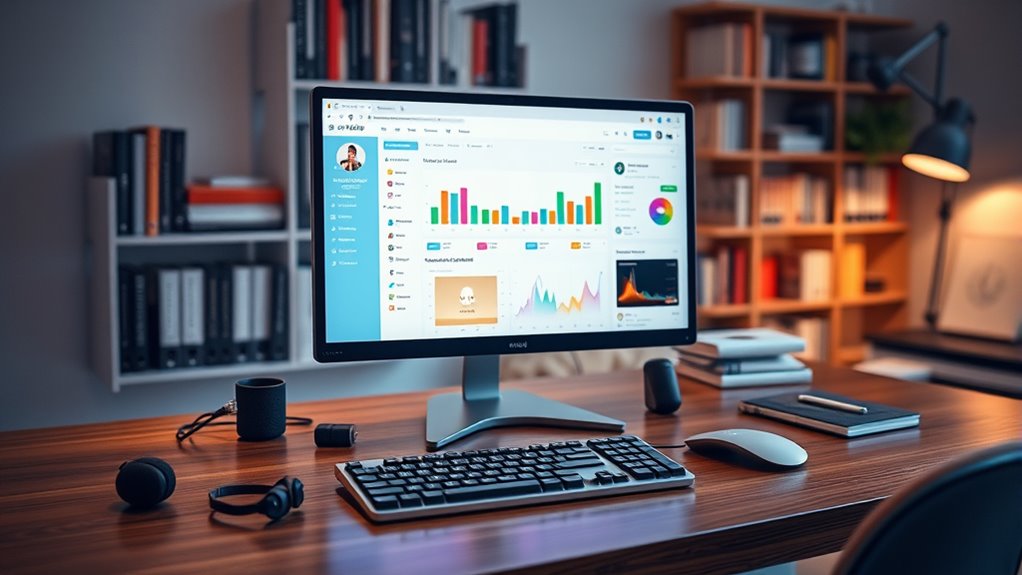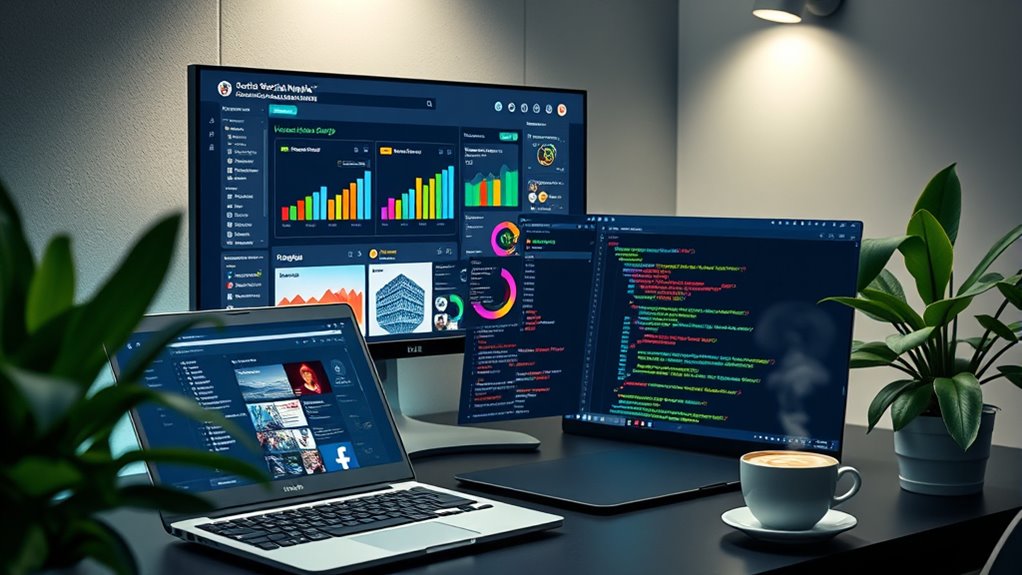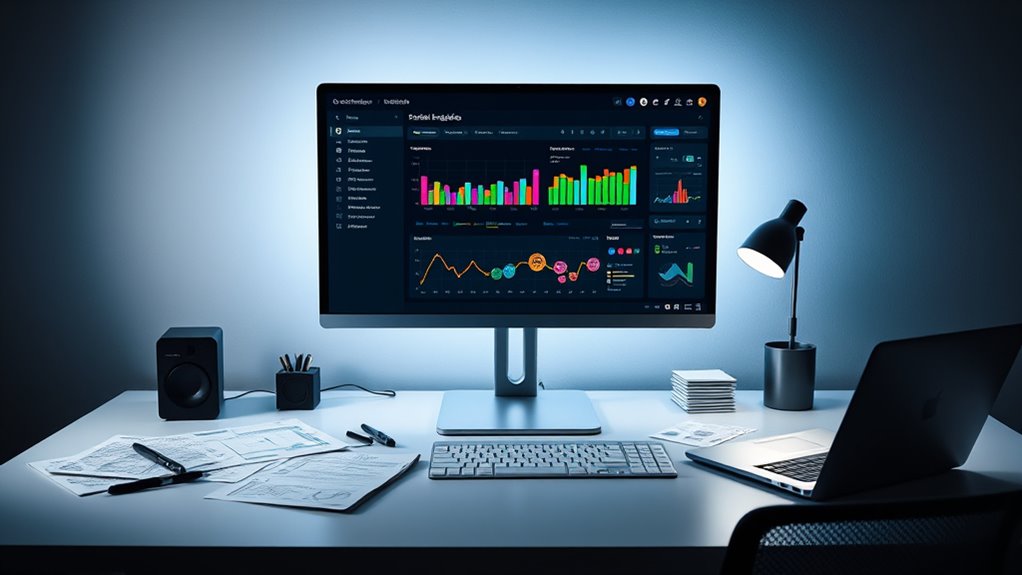To create a social media dashboard with Vibe Coding, start by outlining your project requirements in natural language. Tools like Cursor and Replit make it easy to translate these needs into functional code. Focus on essential features such as engagement tracking, content scheduling, and real-time updates. Be sure to customize your dashboard for user experience and security. If you want to explore each step and enhance your dashboard, keep going for more insights.
Key Takeaways
- Define specific goals and key performance indicators (KPIs) to guide your social media dashboard creation using Vibe Coding.
- Utilize tools like Cursor and Replit to facilitate AI-assisted coding and project management for developing the dashboard.
- Design a user-friendly layout with customizable templates to enhance navigation and data visualization.
- Integrate real-time data updates from multiple social media platforms for comprehensive performance analysis.
- Implement regular testing and code audits to ensure functionality, security, and adherence to coding standards.
Understanding Vibe Coding and Its Applications

Vibe coding revolutionizes how we approach software development by allowing you to describe your project in natural language, which the AI then translates into code. This AI-assisted programming method focuses on what your software should do, leaving the implementation to the AI.
Coined by Andrej Karpathy in February 2025, vibe coding emphasizes high-level, conversational development, making it accessible for non-programmers. You can interact with AI tools like Cursor Composer and SuperWhisper, which generate code while minimizing manual review. This approach not only accelerates development but also lowers barriers to software creation, redefining roles in product creation by centering on user needs. However, it’s crucial to maintain human oversight to guarantee quality and address any bugs that may arise.
Essential Features of a Social Media Dashboard

Creating an effective social media dashboard is essential for tracking your brand’s performance and managing content efficiently. Start by monitoring engagement metrics like likes, comments, and shares to gauge interactions.
An effective social media dashboard is crucial for tracking performance and managing content efficiently through engagement metrics.
Analyze your reach and impressions to see how many users view your content. Keep an eye on your follower growth rate and post click-through rates to evaluate your strategies.
Incorporate content scheduling tools and a content calendar to streamline your posting. Include customizable reports and automated analytics to save time.
Make sure your dashboard supports multi-platform integration and offers real-time updates. Finally, prioritize user experience with customizable layouts and mobile accessibility, so you can manage your social media anywhere, anytime.
Tools for Vibe Coding: Cursor and Replit

In today’s fast-paced development landscape, tools like Cursor and Replit are revolutionizing the way you approach coding.
Cursor stands out with its AI-assisted coding features, offering project management and AI-based code completion. You can customize models or use the built-in Cursor Composer for visual editing. Additionally, Cursor is a tool for coding without traditional programming, which makes it accessible for users at any skill level.
On the other hand, Replit provides a cloud-based platform that integrates AI agents to enhance your coding experience. With automatic code completion and debugging tools, Replit makes collaboration easy within its vibrant community.
Both tools leverage popular AI models like CLA 3.7 Sonnet, allowing you to interact through prompts and let AI handle the coding tasks.
Embrace these innovative tools to streamline your development process and enhance productivity.
Step-by-Step Guide to Building Your Dashboard

Once you’ve laid the groundwork with your project plan, you can immerse yourself in building your social media dashboard.
Start by utilizing Vibe Coding’s automated backend setup, which simplifies the integration of social media APIs like Twitter and Facebook. Automate data collection is essential to saving time for strategic decision-making.
Next, focus on designing a responsive UI that includes essential components such as charts and data tables.
Don’t forget to use pre-built UI templates to speed up your design process.
As you integrate APIs, make certain you handle data processing and error management effectively.
Finally, consider deploying your dashboard on a cloud platform, allowing for scalability.
Throughout this process, keep testing your features and gather user feedback to refine your dashboard.
Customizing Your Dashboard for Unique Needs

While customizing your dashboard, it’s crucial to focus on your specific needs and objectives. Start by identifying your key performance indicators (KPIs), aligning them with your business strategy. Set achievable targets based on historical data and industry benchmarks. Utilize customizable templates to streamline setup, and tailor the layout to fit your workflow. Integrate data from various social media platforms for a thorough view and include branding elements for consistency. Use analytics tools to filter metrics and automate reporting, ensuring real-time data access. Implementing predictive analytics can help you anticipate trends and improve decision-making. Additionally, employing personalized learning approaches can enhance user engagement by catering to individual preferences. Enhancing your dashboard with NLP technology can further improve customer interactions and insights. Enhance functionality with scheduling tools, content calendars, and competitor analysis features. Finally, prioritize user-friendly design and mobile accessibility to make your dashboard intuitive for all users. Investing in social media dashboards can significantly improve your overall management efficiency.
Addressing Code Quality and Security Concerns

Customizing your dashboard sets the stage for effective social media management, but addressing code quality and security concerns is vital for maintaining a robust application.
AI-generated code can become complex, making it essential to implement best practices. Pairing citizen developers with experienced professionals helps refine this code for production. Additionally, the rise of citizen developers enables more individuals to create unique solutions, but emphasizes the need for oversight in the development process.
Remember, while vibe coding excels at rapid prototyping, scaling requires thorough oversight to guarantee stability. Regular code audits and adhering to coding standards can considerably reduce security vulnerabilities.
Utilizing secure AI tools can also mitigate risks. By prioritizing code readability and maintaining clear documentation, you’ll guarantee that the dashboard remains maintainable and understandable, setting a strong foundation for your social media strategy.
Future Trends in Vibe Coding and Dashboard Development

As the landscape of app development evolves, vibe coding is set to revolutionize how you create and manage social media dashboards. AI-driven development will allow you to build apps from simple descriptions while integrating domain-specific knowledge for more targeted solutions. You’ll collaborate with AI to streamline repetitive tasks, focusing on creativity instead. Vibe coding enhances accessibility, enabling non-developers to craft functional apps easily.
Enhanced prototyping means you can quickly develop and test dashboard ideas, ensuring rapid feedback. Expect integrated data insights, automated reporting, and customizable templates, making it effortless to tailor dashboards to your business needs. With AI-assisted visualization, your insights will be more accessible, helping you make informed decisions faster than ever.
Frequently Asked Questions
Can I Use Vibe Coding Without Prior Coding Experience?
Yes, you can use vibe coding without prior coding experience. Tools like Cursor and ChatGPT make it easy to generate code through simple chat interfaces.
With these AI-assisted tools, you can quickly create projects without deep technical knowledge. However, keep in mind that while vibe coding is great for prototyping, you might face challenges with debugging and understanding complex concepts.
Embrace your creativity and explore the possibilities that vibe coding offers!
How Does Vibe Coding Impact Team Collaboration?
Think of vibe coding like a jazz band, where improvisation leads the way. It can enhance team collaboration, allowing you to adapt quickly and experiment freely.
However, without clear communication and documentation, you might find yourself playing out of sync. Knowledge silos can form, making it hard for everyone to stay aligned with project goals.
While flexibility fosters creativity, it also poses risks, causing potential misalignment and inconsistent outputs.
What Programming Languages Are Supported in Vibe Coding Tools?
When using vibe coding tools, you’ll find support for popular programming languages like C and Python.
While there’s flexibility in choosing languages, JavaScript frameworks such as Vue.js and Nuxt are particularly favored.
AI-driven tools handle many implementation details, making it easier for you to work across different languages.
This means you can focus on your project without getting bogged down by language-specific challenges, enhancing your overall coding experience.
Are There Limitations to Ai-Generated Code in Vibe Coding?
Yes, there are limitations to AI-generated code in vibe coding. You might find it hard to comprehend the code, making debugging a challenge.
Additionally, the logic can be a black box, leading to maintenance issues. Relying too much on AI can hinder your problem-solving skills, and you may not fully grasp security implications, risking vulnerabilities.
Ultimately, AI-generated code can contain logical errors or non-optimal solutions, affecting overall performance.
How Can I Troubleshoot Issues With My Vibe-Coded Dashboard?
When troubleshooting your vibe-coded dashboard, think of it as a garden needing care. Start by refining your initial prompts, like nurturing seeds to guarantee they sprout correctly.
Regularly review the code, pruning away inefficiencies. Implement thorough testing to catch issues early, much like checking for weeds.
Finally, integrate seamlessly with existing frameworks, making sure everything grows together harmoniously. With these strategies, you’ll cultivate a healthier, more robust dashboard experience.
Conclusion
To sum up, building a social media dashboard with vibe coding is like crafting a personalized digital workspace. By understanding the tools and features, you can create a vibrant hub that meets your unique needs. Remember to prioritize code quality and security as you navigate this exciting journey. As trends evolve, keep your dashboard adaptable, ensuring it remains a beacon of creativity and efficiency in the ever-changing landscape of social media. Embrace the vibe, and let your ideas shine!









